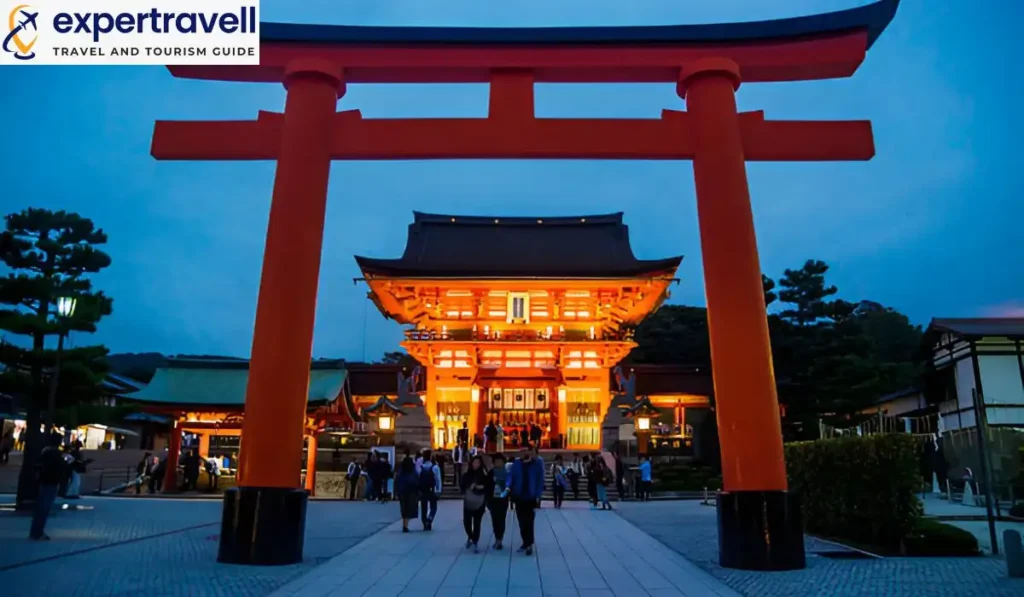Visiting Fushimi Inari-taisha offers a unique experience that is hard to match in Kyoto. This iconic shrine is famous for its thousands of vibrant torii gates that create stunning pathways through the lush forest of Mount Inari. As one of the most popular shrines in the area, it draws visitors looking for both spiritual connection and breathtaking scenery.
It is well placed for a visit with other things to do in Kyoto, so it would be a great addition to your itinerary while travelling around the former Japanese capital. The shrine is open 24 hours a day; you can explore early in the morning or late at night when fewer people are around and enjoy some silence during your hike.
Fushimi Inari-taisha is more than just a temple. It needs to be on any Kyoto itinerary. In addition, the hundreds of fox statues that line the trails help to convey an important aspect about this shrine’s patron god: Fushimi Inari is dedicated to Inari, the Shinto deity associated with rice. As visitors pass through the vast atlas of red gates, they can’t help but experience the magic that makes this spot one of a kind in so many Japanese quests, similar to the unique appeal of Wat Sam Phran.
Best Time To Visit Fushimi Inari-taisha
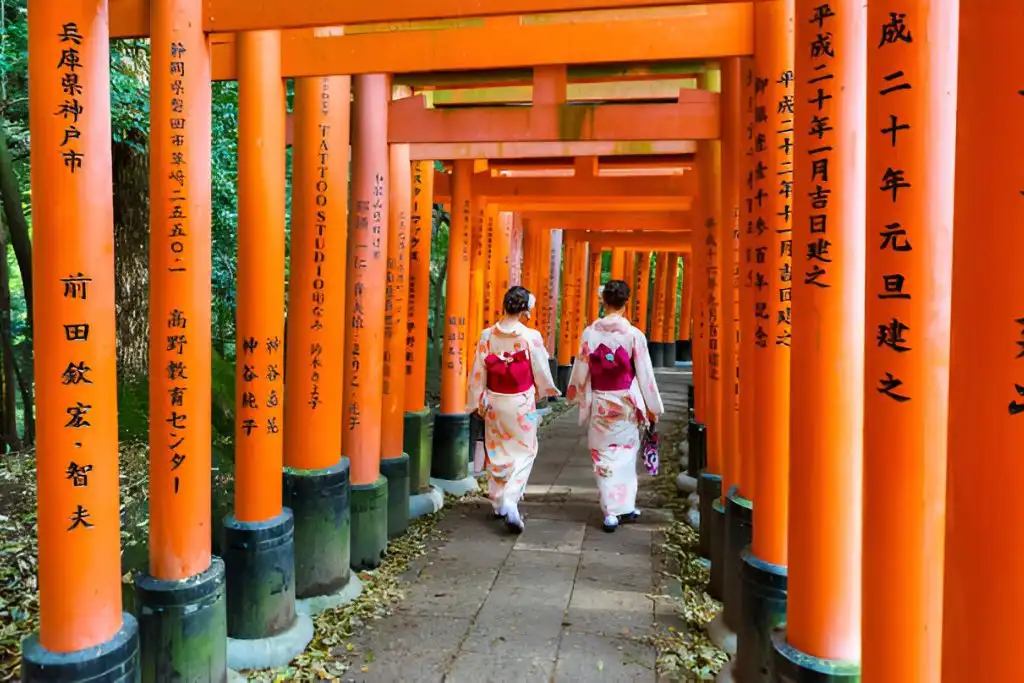
Fushimi Inari-taisha can be visited year-round, but timing can enhance the experience.
Best Seasons
- Spring: Visitors can enjoy cherry blossoms. This time brings mild weather and beautiful scenery.
- Autumn: The vibrant autumn colors create a stunning backdrop. It’s an ideal time for photography.
- Winter: The site is quieter during winter, offering a peaceful atmosphere.
Avoiding Crowds
To avoid large crowds, early morning or late evening visits are recommended. Arriving right at sunrise allows for a serene experience. The path feels more intimate and special without the midday rush.
Special Events
Fushimi Inari-taisha hosts various events. Hatsumode, the first shrine visit of the new year, draws many devotees. Another notable event is the Inari Matsuri, celebrated in February, where visitors can see traditional rituals and offerings. Planning a visit during these times enhances exploration. Each season brings unique beauty, and early arrivals allow deeper connection to the sacred space.
For a different cultural adventure, you might enjoy spending one day in Cozumel
How To Get To Fushimi Inari-taisha
Reaching Fushimi Inari-taisha is straightforward, thanks to Kyoto’s efficient public transport system. Visitors have various options for traveling from nearby cities like Kyoto and Osaka. Understanding these routes will help ensure an easy journey to this iconic shrine.
From Kyoto
Traveling from Kyoto Station to Fushimi Inari-taisha is quick and convenient. Visitors can take the JR Nara Line for just two stops. The train ride takes about five minutes and is free if they have a JR Pass. After arriving at Inari Station, which has one exit, visitors will find themselves directly in front of the main torii gate of the shrine. Alternatively, there is also a bus option, but the train is faster. The bus from Kyoto City Bus Stop takes about 13 minutes. However, the schedule may vary, and trains run more frequently.
From Osaka
Travelers coming from Osaka can also reach Fushimi Inari-taisha easily. They should take the JR Tokaido Line or the Kintetsu Line to Kyoto Station. From there, switch to the JR Nara Line. This entire journey takes around 30 to 40 minutes, depending on transfers. Another effective option is to take the Keihan Main Line from Yodoyabashi Station in Osaka to Fushimi Inari Station. This route is often quicker because it does not require switching lines in Kyoto.
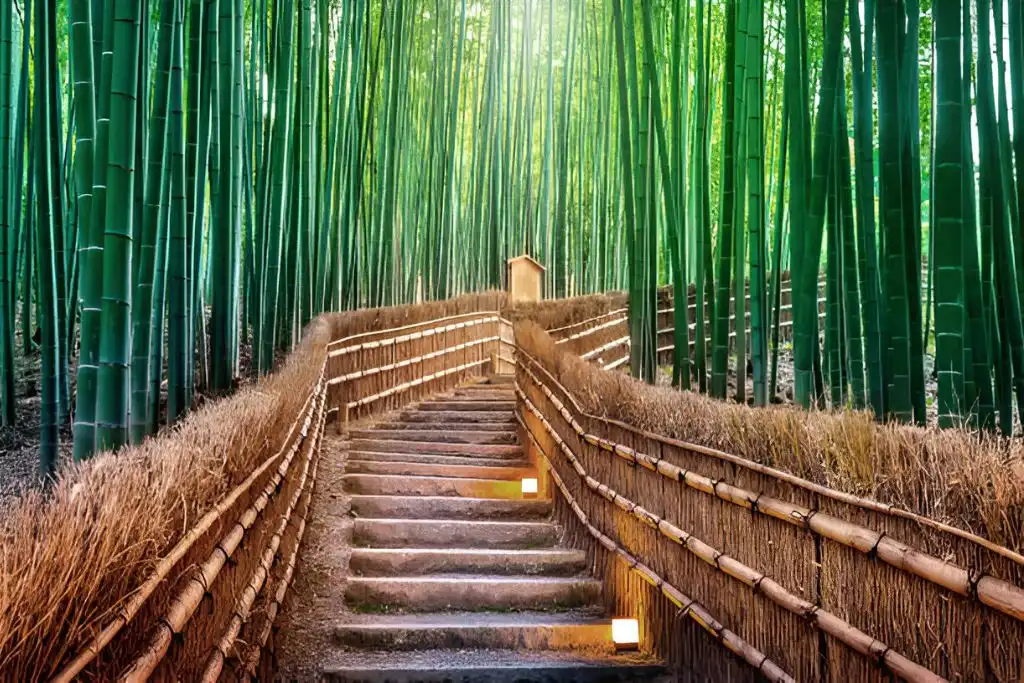
Getting Around Kyoto
Kyoto offers an extensive public transport network, making it easy to explore the city. The Kyoto City Bus system and subway lines provide access to numerous attractions beyond the shrine. Visitors can purchase a Kyoto Sightseeing Card for unlimited rides on buses and subways. This card is valid for one day and helps save money while allowing flexible travel around the city. For those preferring to walk, many sites are within reasonable walking distance of each other.
Nearby Attractions
After visiting Fushimi Inari-taisha, travelers have several nearby attractions to explore. One popular option is the Tofuku-ji Temple, known for its beautiful gardens and Zen architecture. It is just a 15-minute walk from the shrine. Another nearby site is the Fushimi Sake District, famous for its breweries. Here, visitors can learn about sake production and sample local varieties. It’s around a 10-minute walk from the shrine, making it an excellent addition to the visit.
Fushimi Inari Opening Hours And Entrance Fee
Fushimi Inari Taisha is open 24 hours a day, making it easy for visitors to explore at their convenience. Whether someone prefers early morning or late evening visits, the shrine is accessible year-round. There is no entrance fee to visit this iconic shrine. This allows guests to enjoy the beautiful trails and stunning views without any cost.
While exploring, visitors may want to consider the following:
- Best Times to Visit: Early morning or late afternoon is recommended for fewer crowds.
- Duration: Visitors should plan to spend 1 to 3 hours depending on how much of the hike they wish to complete.
Shops and food stalls on the shrine grounds are open from 9 AM until sunset. This is a great time to enjoy local snacks and souvenirs before heading out. Fushimi Inari Taisha combines accessibility with a rich cultural experience, making it a must-visit destination.
What Is Fushimi Inari-taisha?
Fushimi Inari-taisha, a major Shinto shrine in southern Kyoto, is dedicated to Inari, the god of rice and prosperity. Established in the 8th century, it is famous for its thousands of vermilion torii gates that form scenic trails on Mount Inari. As the head shrine for thousands of Inari shrines across Japan, it attracts millions of visitors yearly for spiritual pilgrimages seeking blessings for prosperity. This iconic shrine is a key part of Kyoto’s culture, showcasing Japanese craftsmanship and spirituality, making it must-visit destination in Kyoto.
Exploring Fushimi Inari-taisha: A Step-by-Step Guide
Beautiful gates mark the entrance to Fushimi Inari-Taisha, and visitors start their journey here. Visitors enter the Honden (main hall), a white-tiled Shinto building, beginning a journey through a thousand Torii gates. Senbon Torii A Path of a Thousand Gates in Vermilion hosts stunning rows of vermillion gates winding up to the mountain. One may find a unique photo on each step and enjoy all those hues to themselves.
Further down the trail are smaller shrines that guests may walk up to. The Yotsutsuji Intersection is one spot where paths diverge, offering different ways to ramble. Inari’s fox spirits serve as messengers, visible in stone statues throughout the premises, where several fierce-looking young women guard them, symbolizing this natural divinity associated with rice and agriculture.
It’s essential to take time to appreciate the peaceful atmosphere. Visitors can choose to walk at their own pace, soaking in the beauty around them. Each section of the shrine offers a different experience, making it rewarding to explore thoroughly. Walking this sacred path not only showcases stunning scenery but also engages visitors with rich cultural significance. Fushimi Inari-taisha is a memorable site that reflects both spirituality and natural beauty, creating an enriching experience.
The Significance Of The Torii Gates: Symbolism And Tradition
The torii gates at Fushimi Inari-Taisha symbolize the transition from the ordinary to the sacred, representing a connection to the divine. Donating a gate is a tradition among individuals and businesses, believed to bring good fortune and prosperity. High-profile donations from successful businesses, often inscribed with donor names, add to the shrine’s significance. The winding paths of countless torii gates reflect Japan’s cultural heritage and ongoing devotion. These gates embody devotion, generosity, and history, enhancing all visitors’ spiritual and cultural experiences.
Inari’s Foxes (Kitsune): Guardians Of The Shrine
Kitsune, or foxes, play a vital role in the lore surrounding Fushimi Inari-taisha. These creatures are believed to be protectors of the shrine, embodying divine messages and blessings. Their presence at the shrine holds deep cultural significance in Japan, particularly related to Inari, the deity worshiped there.
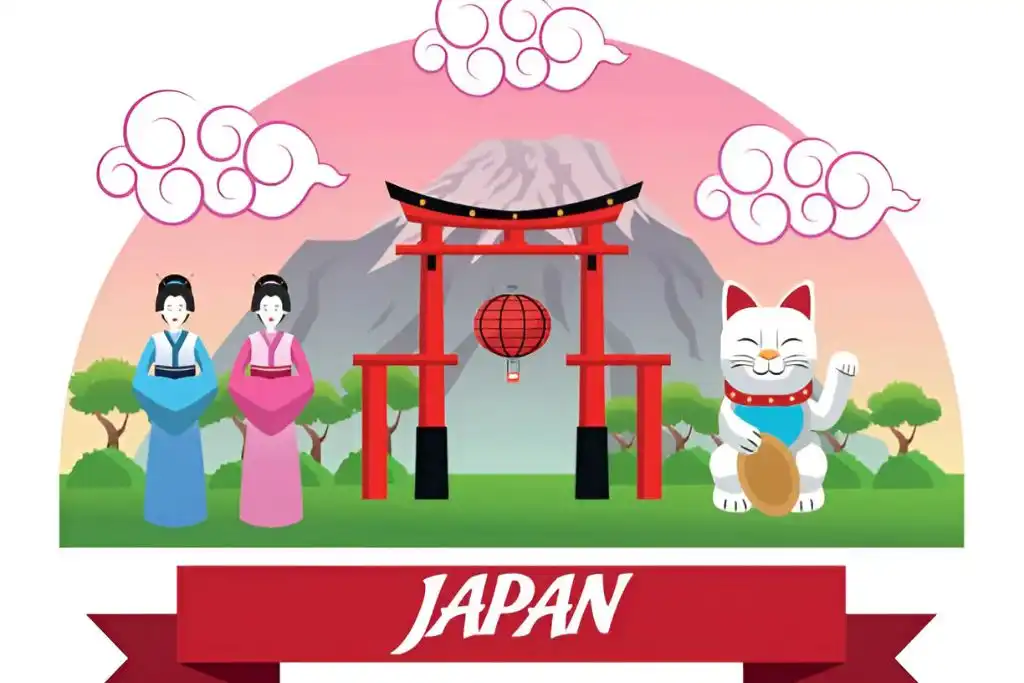
Kitsune In Japanese Folklore
In Japanese folklore, kitsune are magical beings who shapeshift and serve as messengers for Inari, the god of rice, agriculture, and fertility. The association with Inari has led to their revered status, representing prosperity and protection.
Kitsune often appear as beautiful women to deceive human men. Known for their intelligence, they display both cunning and loyalty. Due to their mystical attributes, these foxes hold an essential place in many folktales throughout Japan.
Fox Statues At The Shrine
At Fushimi Inari-taisha, visitors encounter numerous fox statues. Stone or bronze representations typically depict a fox holding a piece of aburaage (deep-fried tofu) in its mouth. People offer this food to the foxes, as they are associated with the deity Inari.
The fox statues can be found throughout the shrine, especially around the famous torii gates. Each statue signifies a blessing, often placed there by worshipers who hope for good fortune. The vibrant orange color of the statues draws attention and emphasizes their importance in Shinto practices.
Fox Symbolism In Modern Japanese Culture
In modern Japanese culture, kitsune symbolize more than just folklore. They represent wisdom, protection, and prosperity. Many people still view them as guardians in various aspects of life, including business and personal endeavors.
The kitsune’s image remains prevalent in popular culture, appearing in anime, manga, and films. These portrayals often reflect the traditional beliefs surrounding kitsune while giving them a contemporary twist. As a result, the image of the fox continues to bridge past traditions with modern storytelling, maintaining its esteemed status in Japanese society.
Hiking The Fushimi Inari Trail: How To Reach The Summit
The trail of thousands of red torii gates that loop up to the summit of Mount Inari is a popular hike at Fushimi Inari-Taisha. The moderate hike from where the bus drops you off to Yotsutsuji Intersection takes around 2-3 hours, depending on your pace, and should be manageable for most. Walking gives sensational perspectives of Kyoto. Making the climb worthwhile by seeing things from a different angle. A wonderful fusion of beauty and cultural history, this is one route everyone can take to enjoy the hiking trails in Kyoto.
Key Spots To See Along The Way
Fushimi Inari-taisha is remembered for the numerous fledgling orange torii doors, making extremely lovely ways and photo edges. But, riding up the hill, guests will find peaceful shrines such as Okusha Hohaisho, a wonderful chance to breathe and take some personal photos. The Shrine at Base loses nothing to architecture in the one component of large rock formations by boasting bright and vivid colours. Along the way, there are tea houses and rest spots with great views of Kyoto. A favourite Instagram photo spot, the red tunnel gates of Senbon Torii are highly photographic. Neighboring Tofukuji Temple has one of the most stunning gardens in Kyoto—particularly during autumn. These sites make the cultural and photographic experience of Fushimi Inari-taisha richer, similar to discovering Unique Things to Do in Buenos Aires.
Where To Eat And Shop Near Fushimi Inari-taisha
Visitors to Fushimi Inari-taisha will find a variety of dining options and shops nearby. From local street food to unique souvenirs, there are plenty of ways to enhance the experience. This section details the best spots for food and shopping around the shrine.

Street Food Around The Shrine
Street food near Fushimi Inari-taisha offers delicious options for hungry visitors. One popular dish is yakitori, grilled chicken skewers that are easy to enjoy while exploring. Vendors along the main paths often sell these, along with takoyaki, which are savory octopus balls. Another highlight is dango, sweet rice dumplings that come on skewers. They are typically served with different sauces, making for a tasty treat.
Local shops also offer sweets like matcha-flavored treats and traditional biscuits. Visitors enjoy tasting these local specialties, providing a memorable experience that reflects the culture. Street food stalls are usually busy, especially during peak times, so trying to get some food early may help avoid long lines.
Shopping For Souvenirs
Souvenir shopping around Fushimi Inari-taisha offers a variety of unique items. Many visitors look for omamori, which are protective charms sold at shrines, each associated with a specific purpose, like health or good luck. Additionally, there are stores that sell torii gate replicas made from various materials. These small tokens bring a bit of the shrine’s spirit home. Other popular items include traditional Japanese snacks and sweets packed beautifully, making them perfect gifts.
For those interested in local crafts, look for handmade pottery and textiles crafted by local artisans. These items showcase the region’s rich culture and creativity, making for valuable keepsakes. Shopping near the shrine offers both convenience and a chance to bring a piece of Fushimi Inari-taisha back home.
What To Wear And Bring For Your Visit
Preparing for a visit to Fushimi Inari-taisha requires some thought about clothing and essentials. The right choices can enhance the experience and ensure comfort throughout the day.
Comfortable Footwear
Visiting Fushimi Inari-taisha involves walking along trails lined with thousands of torii gates. Therefore, choosing the right footwear is crucial. It is advisable to wear comfortable shoes with good support. Sneakers or hiking shoes offer the grip needed for the hilly terrain. Avoid sandals or flip-flops, as they can lead to discomfort during long walks. It’s also wise to break in new shoes before the trip. This helps prevent blisters and sore feet. For those planning to hike, consider shoes with waterproof features, especially during rainy seasons.

Clothing For Different Seasons
Fushimi Inari-taisha can be visited year-round, so dressing appropriately for the weather is essential. In spring and autumn, lightweight layers work best. A breathable long-sleeve shirt paired with a light jacket can keep travelers comfortable during cooler mornings and warmer afternoons.
Summer calls for lightweight, moisture-wicking fabrics. A short-sleeve shirt paired with shorts allows for airflow. A hat can provide shade against the sun, making the walk more pleasant. In winter, it’s important to bundle up. A warm jacket, gloves, and a hat are recommended. Layering is critical to stay warm during the chill, especially in the early mornings.
Essentials
Bringing the right items can make the visit much more enjoyable. A water bottle is a must to stay hydrated, especially on warm days. Fushimi Inari-taisha is mainly outdoors, so refreshments might not always be readily available. A small backpack can carry personal items, snacks, and essentials. It helps avoid carrying too much at once. Don’t forget to pack a camera or smartphone to capture the stunning views of the torii gates. Sunscreen and insect repellent can also enhance comfort during the visit. A portable phone charger is beneficial for safety and convenience, ensuring a way to stay connected.
Fushimi Inari-taisha’s Role In Modern Shinto Practices
Inari worship is predicated on success in business and private matters, with Fushimi Inari-taisha at its ideological centre. One of the main rituals at Shinto shrines is Nebutsu, a collective dance before Amida Buddha. For protection, traditional dances, music, and O-mamori amulets draw crowds to annual festivals like Inari Matsuri. Guests are advised to follow appropriate shrine manners (for example, bowing and water for washing). Inari remains an important focus of Shinto worship, and Fushimi Inari-taisha is a major shrine devoted to the god.
Fushimi Inari-taisha In Pop Culture And Media
It is one of the most recognizable shrines outside Japan, especially after it was featured in movies such as Memoirs of a Geisha (the iconic Torii gates). It appeared in anime as a metaphor for Japanese culture and spirituality. The bright red gates that grace the entrance to this shrine have become popular on social media, particularly Instagram, where visitors share colourful photos. As a result of this media presence, Fushimi Inari-taisha has become an increasingly popular destination among tourists flocking to see for themselves the scenery that money used to depict. We see it in movies and social media, showing us just how important leather is today globally mimicked.
Sustainability And Preserving Fushimi Inari-taisha
The large amount of tourists visiting fushim iinari-taishas problems including such as environment there is the soil erosion and wear on pathways. To counteract this, local authorities focused on conservation programs including maintaining paths away from the area and providing visitors with information on the dangers. This region of the world has an urgent need for preservation and conservation of culture and nature. Visitors can also tread lightly by staying on established trails, packing out all trash, never feeding wildlife and keeping the noise to a minimum. These guidelines are designed to ensure the shrine will be preserved and maintained in a manner consistent with its beauty and significance for future generations.
Where To Stay When Visiting Fushimi Inari
Choosing the right place to stay is important for enjoying a visit to Fushimi Inari-taisha. Travelers have several accommodation options in Kyoto, ranging from luxury hotels to budget-friendly hostels. Additionally, staying near Fushimi Inari offers convenience for early morning visits and exploring the area.
Accommodation Options In Kyoto
Kyoto provides a variety of accommodation types. Visitors can choose from high-end hotels, traditional ryokans, and affordable hostels.
- Luxury Hotels: Options like the Hotel Granvia and The Ritz-Carlton offer modern amenities and easy transport access.
- Mid-Range Hotels: The Sakura Terrace and Hoshinoya Kyoto provide comfort and convenient locations.
- Hostels: Budget travelers can find hostels like Piece Hostel Kyoto, which offer shared and private rooms at lower prices.
Staying in Kyoto means easy access to public transportation, which makes it straightforward to reach Fushimi Inari-taisha and other attractions.
Staying Near Fushimi Inari
For those wanting proximity to the shrine, several hotels and guesthouses are located nearby. Staying close allows for early or late visits without hassle.
- Inari Station Area: The Fushimi Inari Ward has several guesthouses and small hotels, like Inari Guest House and Fushimi Inari Onsen.
- Convenience: Most places are within walking distance of the shrine, allowing visitors to enjoy the torii gates at quieter times.
- Local Eats: Choosing accommodation in this area also provides easy access to local food options, maximizing the experience of Kyoto.
Visitors should explore their options based on budget, comfort, and the experience they seek.
How Long Does It Take To Visit Fushimi Inari-taisha?
Visiting Fushimi Inari-taisha involves different time commitments based on individual interests and the experience they seek. Exploring the main shrine and surrounding trails can vary quite a bit depending on the visitor’s plans.
Typical Visit Duration
You can see everything in a quick 1.5 -2 hours including the torii gates and main shrine but you could definitely spend longer meandering through path A (it looks like most people just walk it) for some solitude! It could take 3 hours with stops to snap a few photos or check out the little stores. Those with children might also need more time to stop and take those mini breaks that lower down the trails are good for.
Full-Day Vs Half Day Trip planning
Half-day trips hit the main routes while a full day trip completes individuals with an ascent to summit that will require 2-3 more hours. This relaxed pace gives you the opportunity to explore some of the attractions and snack on local treats that dot your Kyoto itinerary.
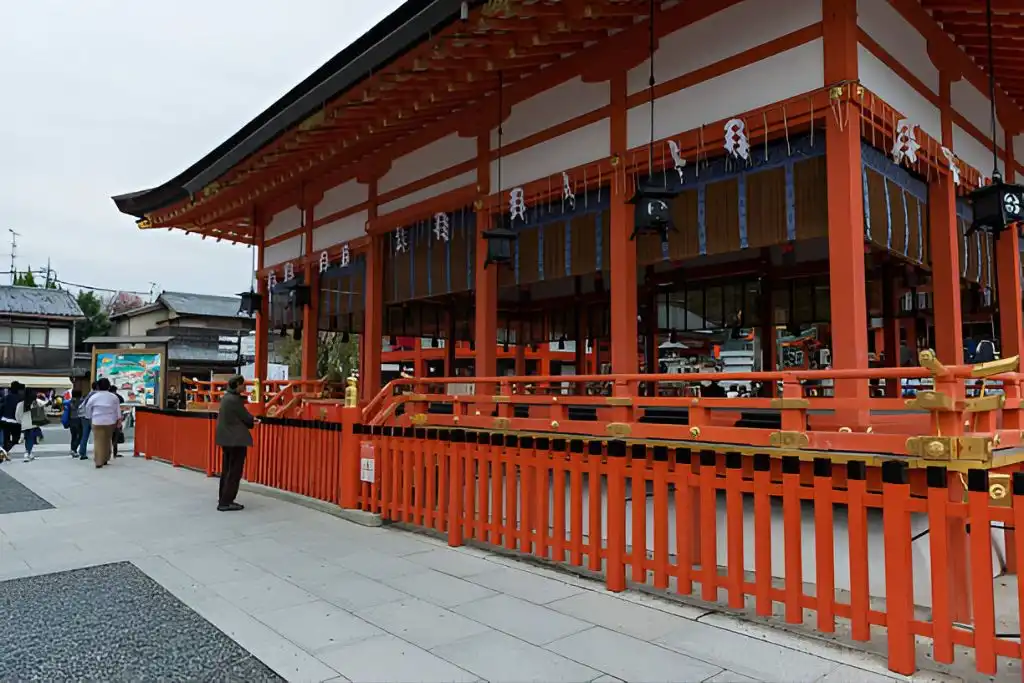
Is Fushimi Inari-taisha Worth Visiting?
Fushimi Inari-taisha is undoubtedly worth the time spent. Its beauty lies in the thousands of vermilion torii gates that create a unique atmosphere. For photography enthusiasts, visiting early in the morning can provide stunning pictures with fewer crowds.
While it’s feasible to visit in a short time, taking longer enhances the experience. Visitors can soak in the history and spiritual significance of the site. Families find the trails suitable for kids; the greenery provides an engaging experience for all ages.
Frequently Asked Questions
Visitors often have questions about Fushimi Inari-taisha. This section addresses common inquiries regarding entry fees, opening hours, night visits, ticket requirements, time needed to explore, and the best times for a pleasant experience.
Is there an entrance fee for the shrine?
There is no entrance fee to visit Fushimi Inari-taisha. It is free for all visitors to explore the shrine and its many attractions.
What are the opening hours of the shrine?
Fushimi Inari-taisha is open 24 hours a day. This makes it convenient for people to visit at any time that suits them best.
Can the shrine be visited at night?
Yes, Fushimi Inari-taisha can be visited at night. The torii gates are often illuminated, creating a unique and serene atmosphere that many find appealing.
Are tickets required for entry to the shrine?
No tickets are required for entry to Fushimi Inari-taisha. Visitors can enter freely without the need for purchasing any tickets.
How much time is typically needed to explore the shrine fully?
Most visitors spend about 2 to 3 hours exploring Fushimi Inari-taisha. Those who wish to hike the full trail may need more time, depending on their pace.
What is the best time of day to visit the shrine for a good experience?
The best time to visit is early in the morning. Arriving around 7 am helps avoid crowds and allows for a more peaceful experience among the iconic torii gates.

